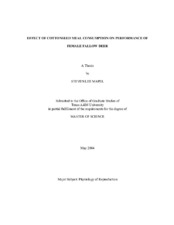| dc.contributor.advisor | Randel, Ronald D. | |
| dc.creator | Mapel, Steven Lee | |
| dc.date.accessioned | 2004-09-30T01:52:27Z | |
| dc.date.available | 2004-09-30T01:52:27Z | |
| dc.date.created | 2005-05 | |
| dc.date.issued | 2004-09-30 | |
| dc.identifier.uri | https://hdl.handle.net/1969.1/325 | |
| dc.description.abstract | The objectives of this study were to determine the effects of gossypol ingestion on reproductive function and productivity of female fallow deer (Dama dama) by measuring endocrine function, pregnancy rates, and body weights of does and fawns. Sixty multiparous fallow does were randomly allotted into three groups corresponding to treatment diet that varied in respect to gossypol content. The does were then separated by treatment into pastures containing two fallow buck sires per pasture. The control group (SBMG), (containing no gossypol in diet) received 362 g soybean meal (SBM) ·animal-1·day-1. The low gossypol group (CSML) was fed 227 g cottonseed meal (CSM; 0.09% free gossypol; determined by HPLC) and 181 g SBM·animal-1·day-1. The high gossypol group (CSMH) received 454 g CSM·animal-1·day-1. Diets were fed daily from 6/16/2003 to 11/20/2003. Blood samples were collected weekly from 8/14/2003 to 11/20/2003 for progesterone and gossypol analysis. Fawns born in June and July of 2003 were weaned 9/18/2003. Bucks were fitted with marking harnesses for the duration of the breeding season and heat marks were recorded daily for estrus detection. Ultrasonography, for pregnancy detection, was performed on 11/20/2003 and 12/15/2003. All groups lost weight from 8/14/03 to 11/20/03. SBMG lost less (P<.05) weight than either CSML or CSMH. Final body weights were 2% greater (P<.02) in SBMG than in CSML or CSMH. Body condition from 8/14/03 to 11/20/03 did not differ (P>.1) between treatments. The pregnancy rate for all groups was 100%. There was no difference (P>.01) in time from weaning to conception (23 d) between treatments. Does in CSMH exhibited decreased (P<.02) progesterone concentrations. Consumption of CSM (free gossypol in amounts up to 0.81 mg·kg-1BW; 0.41 g·animal-1·day-1).did not appear to affect reproductive performance of fallow deer. | en |
| dc.format.extent | 288669 bytes | en |
| dc.format.extent | 69781 bytes | en |
| dc.format.medium | electronic | en |
| dc.format.mimetype | application/pdf | |
| dc.format.mimetype | text/plain | |
| dc.language.iso | en_US | |
| dc.publisher | Texas A&M University | |
| dc.subject | Deer | en |
| dc.subject | Fallow | en |
| dc.subject | Cottonseed | en |
| dc.subject | Gossypol | en |
| dc.subject | Reproduction | en |
| dc.title | Effect of cottonseed meal consumption on performance of female fallow deer | en |
| dc.type | Book | en |
| dc.type | Thesis | en |
| thesis.degree.department | Animal Science | en |
| thesis.degree.discipline | Physiology of Reproduction | en |
| thesis.degree.grantor | Texas A&M University | en |
| thesis.degree.name | Master of Science | en |
| thesis.degree.level | Masters | en |
| dc.contributor.committeeMember | | |
| dc.contributor.committeeMember | Welsh, Thomas, Jr. | |
| dc.contributor.committeeMember | Higginbotham, Billy | |
| dc.type.genre | Electronic Thesis | en |
| dc.type.material | text | en |
| dc.format.digitalOrigin | born digital | en |


